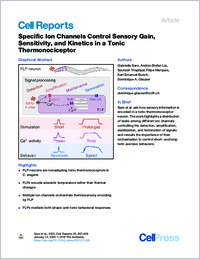Specific ion channels control sensory gain, sensitivity, and kinetics in a tonic thermonociceptor
- Saro, Gabriella Department of Biology, University of Fribourg, Switzerland
- Lia, Andrei-Stefan Department of Biology, University of Fribourg, Switzerland
- Thapliyal, Saurabh Department of Biology, University of Fribourg, Switzerland
- Marques, Filipe Department of Biology, University of Fribourg, Switzerland
- Busch, Karl Emanuel Centre for Discovery Brain Sciences, University of Edinburgh, Scotland
- Glauser, Dominique A. Department of Biology, University of Fribourg, Switzerland
-
14.01.2020
Published in:
- Cell Reports. - 2020, vol. 30, no. 2, p. 397-408.e4
English
Pain sensation and aversive behaviors entail the activation of nociceptor neurons, whose function is largely conserved across animals. The functional heterogeneity of nociceptors and ethical concerns are challenges for their study in mammalian models. Here, we investigate the function of a single type of genetically identified C. elegans thermonociceptor named FLP. Using calcium imaging in vivo, we demonstrate that FLP encodes thermal information in a tonic and graded manner over a wide thermal range spanning from noxious cold to noxious heat (8°C–36°C). This tonic-signaling mode allows FLP to trigger sustained behavioral changes necessary for escape behavior. Furthermore, we identify specific transient receptor potential, voltage-gated calcium, and sodium “leak” channels controlling sensory gain, thermal sensitivity, and signal kinetics, respectively, and show that the ryanodine receptor is required for long- lasting activation. Our work elucidates the task distribution among specific ion channels to achieve remarkable sensory properties in a tonic thermonociceptor in vivo.
- Faculty
- Faculté des sciences et de médecine
- Department
- Département de Biologie
- Language
-
- English
- Classification
- Biological sciences
- License
-
License undefined
- Identifiers
-
- RERO DOC 328171
- DOI 10.1016/j.celrep.2019.12.029
- Persistent URL
- https://folia.unifr.ch/unifr/documents/308463
Statistics
Document views: 110
File downloads:
- pdf: 263
